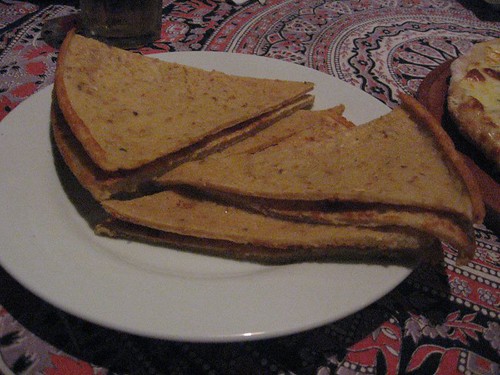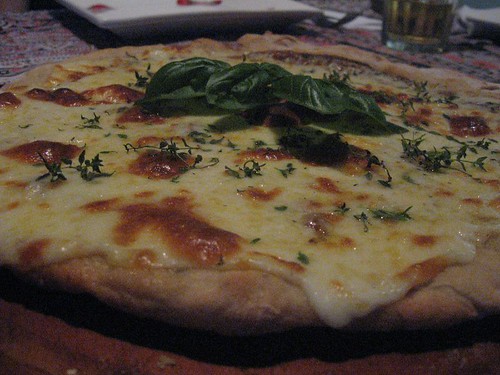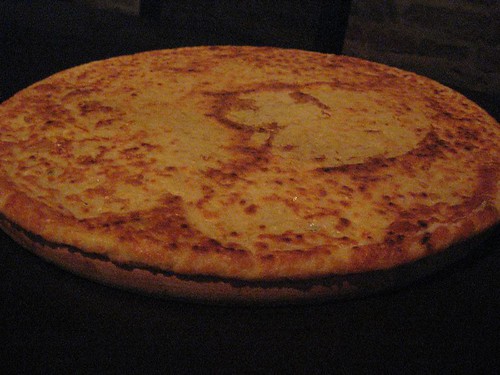Argentina 101: pizza and fainá

As with any country with such a strong culture of immigration, Argentina´s food is a mixture of different cuisines... though the one that clearly wins the race is Italian food, followed by Spanish food.
I know that for all of you, pizza is as common as burgers, but I also know that most of you probably never heard of something called "fainá" in Argentina (from the Genovese dialect) and "farinata" in the rest of Italy.
It´s like a "secondary pizza" used to go with the regular pizza which is made of chickpea flour and seasoned with pepper, sometimes dried onions, a bit of parmessan, etc. 
It´s moist inside and crunchy outside and makes for a great complement to pizza. It can even be topped with pretty much anything and used as a pizza base (I have had it with dried tomatoes, garlic and some parmessan flakes and it is wonderful).
Since I cheated and bought a premixed base of garbanzo/chickpea flour and dried onions, I can´t abide by the recipe I´m about to give you, but it does come from an Italian site, so it should be good, right? ;)
This is what made me turn on the oven when it was 95°F/35°C outside, so if that doesn´t show this is a winning combination, I don´t know what will.
Besides, millions of Italians can go wrong when it comes to choosing a president, but not when it comes to food!!! lol

Fainá or Farinata (adapted from here)[See another interesting recipe at Recipe Zaar]
Ingredients:
• 3 3/4 cups water
• 2 1/3 cups Italian chick pea flour
• 1 teaspoon salt
• rosemary (optional)
• 5 tablespoons extra virgin olive oil
• ground pepper
• parmessan cheese (4 tablespoons)
• onion powder (around 2 tablespoons)
Preparation:
1. Mix the water and the flour with a wooden spoon or a whisk; make sure there are no lumps, add salt to taste, and mix again.
2. Add the rosemary, the parmessan cheese and the onion powder and let it sit for a while (one to three hours or even better overnight).
3. At this point add the olive oil. Remove the rosemary and pour in a baking pan.
It should be about an eighth of an inch thick, perhaps a little more. Put it in a preheated oven at 190-200° C (375-400° F). [I have found some recipes that say you should put the pan in your pizza stone or the hottest part of your oven for 15 minutes and then put it in a colder spot, usually the middle or the top, for 20 minutes more].
4. Remove from the oven when one of the corners (or the edge) starts to appear dark. Sprinkle plenty of pepper and serve.
It is of paramount importance that the pan is perfectly flat and level when in the oven, otherwise one of the corners will be thicker and will be undercooked when the opposite corner starts to darken.


4 comments:
This looks great! I was just looking at chick pea flour yesterday thinking...what do you make with that??? Thanks for being such a great inspiration. I can't wait to get back in the kitchen and play!
What a lovely looking pizza!
Seattle tall poppy- You are welcome! I know, that´s the only use I know for chickpea flour so far...maybe I´ll investigate to see what else can be done with it.
Kristen- Thank you! I was feeling like eating a very simple pizza, so I went for a typical marguerita with tons of herbs, it hit the spot.
Lovely to learn a little bit about Argentina, thanks to you! I think any country that welcomes immigrants becomes infinitely richer culturally for doing so. Here in the U.S., especially in larger urban centers like my Chicago, we enjoy a fabulous international buffet thanks to all the immigrants who've settled here.
Regarding the pan and even cooking, it's important to use a decent pan--otherwise warping can be the culprit, even if your stove is level.
Post a Comment